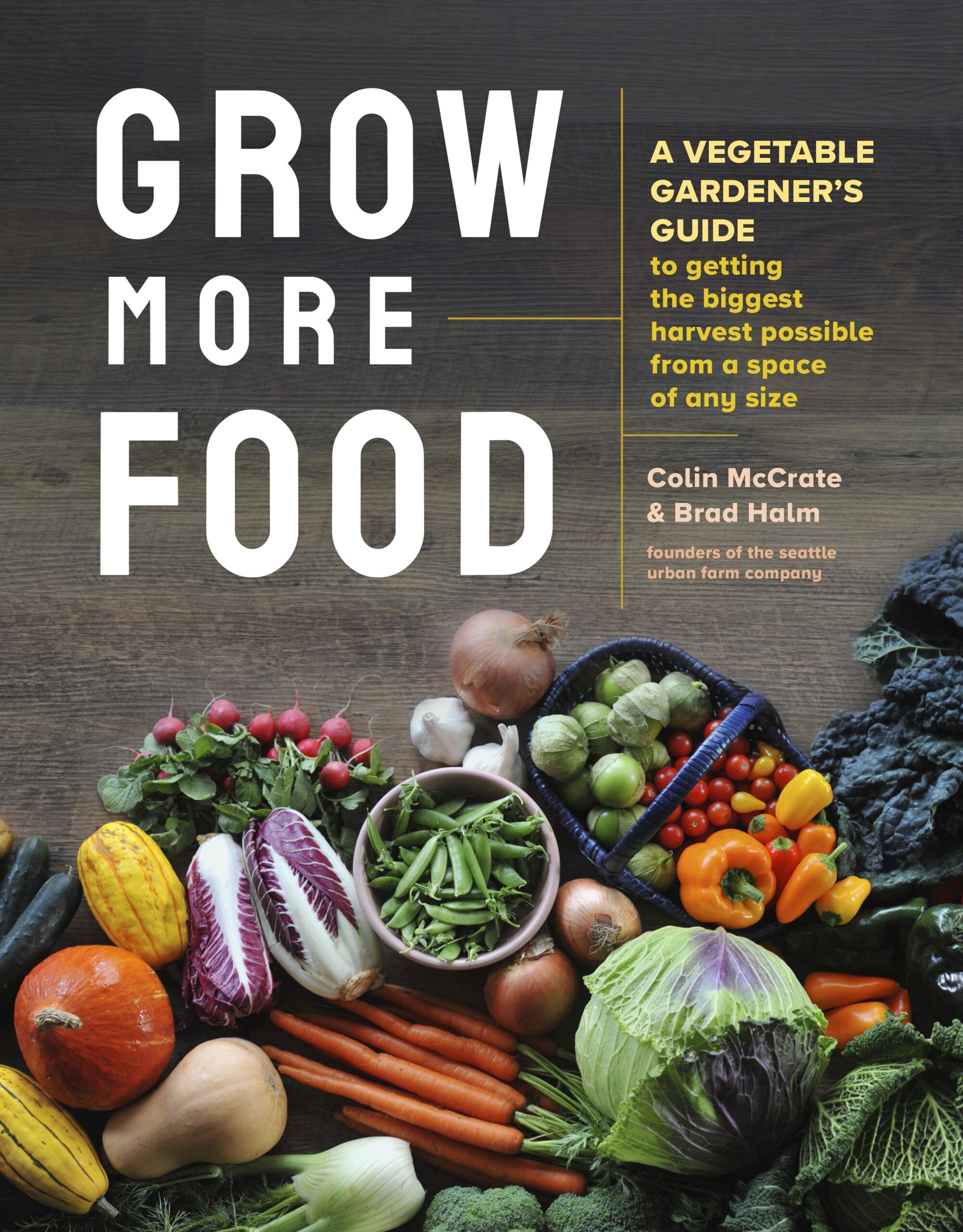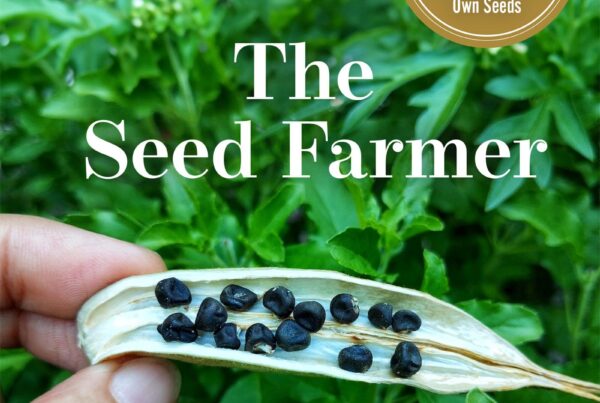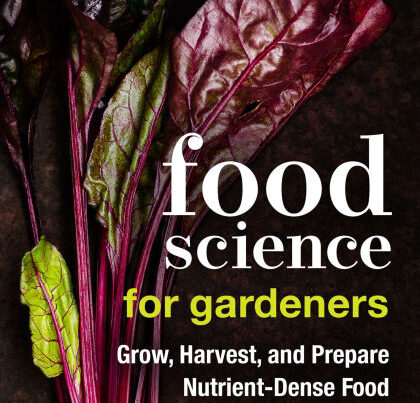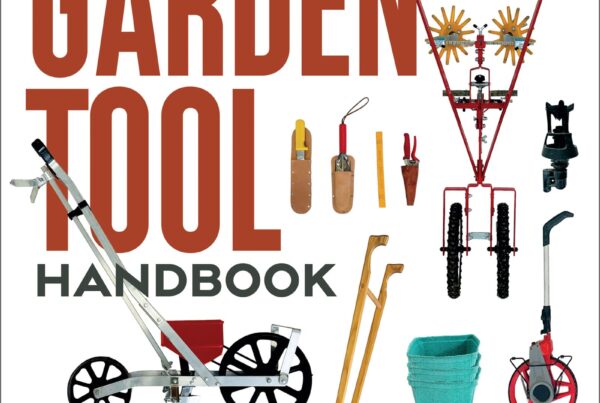This book, Grow More Food, is an updated version of the authors’ 2015 book, High Yield Vegetable Gardening. I have been a big fan of that book since it was published. This book has much the same content but is a larger format with color photos and a larger print size.
Some of the content has been rearranged into a different, more logical, order, (athough a good index does make all topics findable). Some of the more technical or professional terms have been changed from the earlier book. “High yield” has become “productive”. The real or fictional example gardeners have almost disappeared, although drawings of their gardens live on.
If you have High Yield Vegetable Gardening and like it a lot, as I do, you probably don’t need to buy Grow More Food, unless as a gift for a friend, or if you are going to relegate the old version to the greenhouse or shed as a quick reference work. You may like to have the bigger print and the more informative and inspiring color photos in your house for periods of longer contemplation and planning. The new one, however, does not have the lay-flat spiral binding of the old one. The book is definitely a good one to keep on hand, in one version or the other.
The authors founded Seattle Urban Farm Company in 2007, and have been running it since, helping more people grow food. Their focus is to ‘find joy in the simple pleasure of doing a little better each season.” Here they are bringing proven professional techniques for bigger harvests to vegetable gardeners on any scale. The information is presented very clearly, without jargon, so that home gardeners will easily benefit. As I said in my review of High Yield Vegetable Gardening, this also provides newbie professional growers with solid information on techniques that work, without the need to understand everything at once.
These are gardeners after my own heart. Here are details you will benefit from knowing and putting into practice, which are not found in many gardening books: interpreting and using soil tests, choosing onion varieties that work at your latitude, succession planting for continuous harvests, flame-weeding, making soil block mix of the right consistency, dealing with salt build-up in greenhouse soils, minimizing nitrate accumulation in winter greens under cover. There are lots of useful charts.
This edition has more emphasis on building and maintaining good soil, and includes sidebars that dig deep into particular topics such as providing onion flavors all year, making space dedicated to perennial vegetables, converting farm-scale soil amendment rates to garden-scale ones, setting transplants at different depths, hand pollination of cucurbits, and the role of ethylene in crop storage.
The sequence of topics starts with clarifying your garden priorities, planning and record keeping: “It’s no exaggeration to say that a detailed garden plan alone can double or triple the productivity of a garden.” There’s help in choosing the right size of garden for your needs, experience and available time. Next, create a map or drawing of the garden site, including buildings, paving and trees, and consider which crops to grow. The chart of annual crops includes days to harvest and whether to direct sow or transplant. This enables gardeners to compare short-season crops, long-season crops and those in between, to plan food for the whole season; and sequential follow-on crops to make best use of all your space.
Once you’ve figured which crops to grow, how much of each to plant, when (and how often) to plant them, you can create your planting calendar. There are options for format, and a real-life example with arugula. This is followed with a sample section of a planting calendar with harvest tracker and room for notes for next year.
The next big question is “Where?” Make a map of your garden and think about a crop rotation to help you get the best yields by avoiding planting the same crop in the same place each year. A two-year rotation simply has two groups of crops and two beds or plots that flip each year. A three-year rotation can consider which crops need heavy feeding and follow two years of heavy feeders with one of light feeders. Also, if you don’t have soil-borne diseases, consider the counter-intuitive idea of following brassicas with brassicas in the spring and fall of a year, and avoiding brassicas in that bed for the next two or three years. For gardeners like me who grow a lot of brassicas, this makes planning a rotation easier. As well as an overall map of the whole garden, make a planting schedule for each bed, with space to write things down.
A pest and disease management log is another useful piece of record-keeping. It will remind you when to be on the lookout for particular problems, and what strategies worked for you previously. A garden log or diary with entries each day you garden can end with a To-Do list, including things to buy, and watch for.
And that’s just the first part of five. The second is about building healthy soil, providing a diverse ecosystem, high nutrient-level crops and big harvests. There’s information on making boxed beds, if you want to go in that direction, or lasagna beds, where organic materials are piled in layers, and tilled beds incorporating amendments. Tarping (covering soil with tarps to smother weeds) is also discussed. Mulches for pathways are compared. There is a very clear description of taking, submitting and understanding results from soil tests, accompanied by an annotated soil report.
There are clear instructions on making quality compost, buying compost, improving soil with cover crops, and mulching over winter. This chapter includes a manageable chart of “beginner” cover crops (buckwheat, four clovers, peas, vetch, mustard, oats and winter rye). Then comes the weed-reduction chapter. Strategies include dealing with weeds while they are small and seed-free, hoeing (photos of various types, with pros and cons), flaming (good safety tips here!), tarping and mulch.
Part 3 is Get to Know Your Plants – “Grow More Food by Planting the Right Varieties at the Right Time with the Best Care.” Smart gardening, with no wasted effort. Choose suitable varieties (open pollinated ones and hybrids) to match your climate and your goals. Order sensible quantities, store leftovers carefully (cool, dry, dark, airtight, mouse-proof) for use next year. There’s a two-page chart of Seed Lifespan, including parsnips and peanuts, something for every climate. Seed treatments to improve yields are covered, including soaking, scarification and inoculation.
The chapter on transplanting and direct seeding advises on which technique works for which crops. There’s information about supporting plants, from hilling up with soil, to making trellises. Supplemental fertilizers (during the growing season) are useful for some crops, not needed for others (the lists are in the book). The general theme is that heavy feeders and fast-growing crops will benefit. There’s an interesting section on pruning for production, including for good air circulation; for delaying bolting; for encouraging earlier harvests (by root pruning); and removing late flowers to focus energy on maturing fruits already formed.
The goal of managing pests and diseases is not to eliminate them all, but to control levels by cooperating with and stimulating natural processes that restore balance. This process starts with preventing problems, and ramps up if this does not succeed well enough. Develop good soil; attract beneficial insects; use rowcover or netting to keep expected insect pests from vulnerable crops; use deterrent sprays such a baking soda, hot pepper, garlic, kaolin clay for various problems; bring in beneficial organisms.
To nip any problems in the bud, it is important to monitor or scout your gardens at least once a week, looking for problems. Distinguish problems caused by extreme temperatures and water shortage from those caused by pests and diseases. Find good ID resources. You may be able to hand pick or trap enough pests to make the difference between a damaging outbreak and a trivial level. The authors explain why it is unwise to rush for the sprayer. Sprays are a last resort, even organic ones, because they may kill unintended insects, and they leave some of the pests alive to develop resistance, making that spray ineffective in the long run. There’s a two-page chart for pest and disease management strategies.
Part 4 is entitled Create Efficient Systems. It describes how to use your resources well, so time, money and space are not wasted, and you get the best from your efforts. Set up a home nursery to grow your own transplants, and plant the varieties you want in the quantities you want, to fit your schedule. Here are details on light intensity and where on the color spectrum the light should fall. You may be surprised just how much light plants need. For overall plant growth, general full-spectrum lights are just fine for a nursery, where the plants are headed outdoors to the natural source. Growing plants to maturity indoors is another (costly) matter.
The photos on making soil blocks are very helpful, and it’s a topic not covered in many places. Various types of plant container are covered. Making your own seed-starting schedule is explained. There’s info on propagating from cuttings, grafting with silicone clips, and watering or misting tiny plants. The next chapter covers irrigation of more kinds: drip systems (good description and photos for newbies) and sprinklers (including oscillating lawn-type sprinklers, wobblers, impact sprinklers and microsprinklers). This section will clear up a lot of confusion. Whichever you choose, make yourself an irrigation map, helping ensure you run pipelines and hoses along the best route, and set up sensible zones. Designs that minimize the need to move equipment around during the growing season will preserve your sanity and sense of well-being.
Part 5 is Extend and Expand the Harvest. This includes storage. Good techniques and timely harvesting let you get the most food from your crops, and eat them at peak quality and flavor. Extending the growing season includes starting as early as possible, finishing as late as possible, helping crops get through hot weather as well as cold, and planting successions to give you a seamless harvest through the growing season. Try crops you have not grown before.
The section on choosing protective structures will help you think about the pros and cons, costs and benefits of low tunnels (with rowcover or clear plastic), cold frames, greenhouses, high tunnels (also called hoophouses), and combinations of low tunnels inside high tunnels. If you are undecided on this topic, Grow More Food could save you from buying the wrong thing and wasting many times its cover price. And it could save you the big disappointment of not getting the harvests you hoped for. Consider not just cost but also ease of use (let’s enjoy our gardening!), suitability for your climate, and gained productivity. Glass greenhouses and greenhouse heating are often not cost-effective, and heating brings environmental costs too.
When weighing up design features, do the math for your own situation. I dislike the “comb” greenhouse bed design because it doesn’t work so well with drip tape. The authors say it maximizes usable space. But the difference is very small and the disadvantages are several. You lose the staging area of the lengthwise beds design. Many gardening books neglect methods of summer cooling, but the climate emergency is upon us. Here you will find good ideas about shade cloth and using overhead irrigation for cooling.
The next chapter is about timely harvesting and successful storage. Remember when planning your garden to think about how much food you can use, including not just how much your household can eat, but also how much time you have each week for harvesting and storage. There is a good discussion about becoming a skilled harvester. For each likely crop there is a short description of which part to harvest, and how to recognize maturity.
Next is a section on harvesting “hidden” crops – extra harvests form your garden: weeds, less usual parts of crop plants, such as flowers, garlic scapes, carrot leaves, pea shoots and tendrils, and sweet potato leaves. You can harvest more food from the same plants by choosing varieties that provide multiple harvests (loose leaf crops, broccoli side shoots, turnip and beet greens and roots).
There’s a bit on washing crops, and food safety. Then harvesting for maximum freshness and quality, and storage, short and long term. Not everything should be refrigerated! Onions, garlic, winter squash, potatoes and sweet potatoes need to be cured before long-term storage. Be sure to get the details right, or you could have big losses. There is a 4-page chart of storage conditions for various crops. Although I agree with the authors on almost everything they write, I wouldn’t wipe down winter squash with bleach. I’ve never found it necessary.
At the end of the book are worksheets you can photocopy and use. Or you can download them from Seattle Urban Farm. They include a Crop Amount Worksheet, Planting Calendar Worksheet, Planting Dates Worksheet, and Garden Planning Chart. The website also has sample log pages for a specific bed, for the garden as a whole, a pest and disease management log, harvest log, and planting calendar with harvest tracking.
There is a resource section and I was particularly happy to find two resources for non-toxic wood preservatives for garden use. The index looks very thorough – 21 columns for 300 pages.
The Seattle Urban Farm Company has a blog and a podcast, and their Projects page will give you lots of ideas on garden layout and design. Their shop sells training sessions, webinars, and individual coaching.
Book Review by Pam Dawling: , Grow More Food, a Vegetable Gardener’s Guide to Getting the Biggest Harvest Possible from a Space of Any Size by Colin McCrate and Brad Halm. Storey Publishing, 2022, 300 pages, diagrams, $24.95







